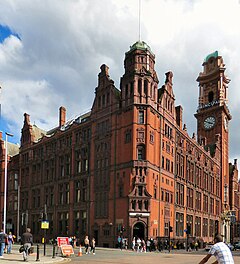Kimpton Clocktower Hotel
| Kimpton Clocktower Hotel | |
|---|---|
 Oxford Streetfaçade with clock tower in 2017 | |
| Former names | The Principal Manchester, Le Méridien Palace Manchester, Palace Hotel |
| Alternative names | Refuge Assurance Building |
| General information | |
| Type | Originally offices for Refuge Assurance; hotel since 1989 |
| Architectural style | EclecticBaroque[1] |
| Address | Oxford Street,Manchester,M60 7HA |
| Country | United Kingdom |
| Current tenants | Kimpton |
| Opened | 1895 |
| Renovated | 1912, 1932, 2016, 2020 |
| Client | Refuge Assurance Company |
| Owner | InterContinental Hotels Group |
| Height | 66 m (217 ft) |
| Design and construction | |
| Architect(s) | Alfred Waterhouse,Paul Waterhouse,Stanley Birkett |
| Designations | |
Listed Building– Grade II* | |
| Official name | Former Refuge Assurance Company Offices |
| Designated | 3 October 1974 |
| Reference no. | 1271429 |
| Website | |
| Official website | |
TheKimpton Clocktower Hotelis a historic commercial building, now a hotel, at the corner ofOxford StreetandWhitworth StreetinManchester,England. The building was originally constructed in segments from 1891 to 1932 as theRefuge AssuranceBuilding.
History
[edit]Refuge Assurance Company
[edit]The first phase of theGrade II* listedred brick and terracottabuilding was designed for theRefuge Assurance CompanybyAlfred Waterhouseand built between 1891 and 1895.[2]The inside was ofBurmantofts faienceand glazed brick. The ground floor was a large, open business hall.[3]It was extended, with a 217-foot (66 m) tower, along Oxford Street by his sonPaul Waterhousebetween 1910 and 1912.[2]It was further extended along Whitworth Street by Stanley Birkett in 1932.[3]
What is now the ballroom was previously the dining hall for employees, with males and females being required to sit separately. Around 2,000 staff were employed. Women had to reapply for jobs if they married,[4]and some areas of the building were for men only.[5]The ballroom in the basement was used as a dance hall for workers in their lunch hour.[6]
After occupying the building as offices for nearly a century, the Refuge Assurance Company moved to the grounds ofFulshaw Hall,Cheshire,on 6 November 1987. The Refuge Assurance Company had discussed converting the building into a new home for theHallé Orchestrawith one of Manchester's cultural patronsSir Bob Scottfor over a year. The £3 million funding required for the project did not materialise and the Hallé subsequently moved from theFree Trade Hallto the newBridgewater Hallupon opening in 1996.[7]Local architecture critic John Parkinson-Bailey noted that "one of the most prestigious and expensive buildings in Manchester lay forlorn and empty except for a caretaker and the ghost on its staircase".[7]
Conversion to hotel
[edit]The structure was converted to a hotel by Richard Newman in 1996 at a cost of £7 million, and was named thePalace Hotel,owned and operated by thePrincipal Hotel Company.[8]Principal Hotels was sold toNomura International Plcin 2001,[9]and they rebranded the hotel asLe Méridien Palace Manchester.WhenLe Méridien Hotelsfaced financial difficulties,[10]the hotel was bought back by a reconstituted Principal Hotels in 2004[11]and again renamed the Palace Hotel. When Principal Hotels decided to brand all their hotels with their corporate name, the hotel was renamedThe Principal Manchester,in November 2016.[12]The current glass dome in the reception area was taken from a Scottish railway station during the conversion to a hotel.[4]
In May 2018, the hotel was sold to theInterContinental Hotels Group.[13]It was announced in February 2020[14]that the hotel would be renamed theKimpton Clocktower Hotelin March, as part of InterContinental Hotels Group'sKimpton Hotelsbrand; however, the hotel was forced to close before the renaming due to theCOVID-19 pandemic.[15]It reopened under the Kimpton name on 1 October 2020.[16]
The hotel is purported to be haunted.[6]One of the staircases is said to be haunted by a grieving war widow who committed suicide by throwing herself down it from the top floor.[4]The staircase in question was only accessible to men at the time.[5]Room 261 is allegedly haunted, with reports of the sound of children playing at night.[17]
See also
[edit]References
[edit]Citations
[edit]- ^Historic England."Refuge Assurance Building (1271429)".National Heritage List for England.Retrieved26 November2012.
- ^ab Former Refuge Assurance Company Offices,Heritage Gateway,retrieved24 October2009
- ^abHartwell, Clare (2001),Manchester,Pevsner Architectural Guides, Penguin Books, p. 180,ISBN978-0-14-071131-8
- ^abcEvans, Denise (6 September 2016)."New Palace Hotel tours reveal secret and hidden rooms".Manchester Evening News.Retrieved11 April2021.
- ^ab"Principal Manchester Hotel: A Glimpse into the Past & Future".23 January 2017.
- ^ab"I would go out tonight: Johnny Marr shares his midnight Manchester odyssey with the world".Manchester Evening News.31 March 2011.Retrieved11 April2021.
- ^abParkinson-Bailey.Manchester: An architectural history.p. 227.
- ^"The Palace Hotel - Oxford Street & Whitworth Street".Retrieved26 November2012.
- ^"Nomura International PLC's Principal Finance Group Buys Principal Hotels - Juergen Bartels Joins Management Team".
- ^"RBS takes its partners in the le Meridien hotel reshuffle".Independent.co.uk.7 December 2003.
- ^"Troy lands Palace again".13 August 2004.
- ^Roue, Lucy (29 September 2016)."The Principal Manchester heads for 'principal' role in city".Retrieved3 October2016.
- ^"IHG adds 13 luxury and upscale hotels in the UK".4 July 2018.Retrieved4 April2012.
- ^"The old Palace Hotel's landmark clock tower is changing AGAIN as Principal brand stripped".Manchester Evening News.26 February 2020.Retrieved3 April2012.
- ^"Manchester hotel jobs at risk as redundancy consultation begins".6 July 2020.
- ^"Kimpton Clocktower Hotel Open in Manchester".
- ^"MANCHESTER ~ Palace Hotel……. | GHOSTLY TOM'S TRAVEL BLOG…."Retrieved11 April2021.
Bibliography
[edit]- Parkinson-Bailey, John (2000).Manchester: An Architectural History.Manchester University Press.ISBN9780719056062.
External links
[edit]





